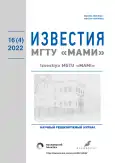Increasing the efficiency of the lubrication system of a modern internal combustion diesel engine
- Authors: Khannanov M.D.1,2, Alimgulov E.R.2, Fardeev L.I.2, Kulikov A.S.2, Gumerov I.F.2, Gubaidullin R.R.3, Mukanov G.Z.3, Doikin A.A.4
-
Affiliations:
- Naberezhnye Chelny Institute of Kazan Federal University
- Scientific and Technical Center of KAMAZ
- Ural Federal University
- Advance Engineering
- Issue: Vol 16, No 4 (2022)
- Pages: 291-301
- Section: Heat engines
- URL: https://journals.rcsi.science/2074-0530/article/view/126637
- DOI: https://doi.org/10.17816/2074-0530-108421
- ID: 126637
Cite item
Full Text
Abstract
BACKGROUND: Leading manufacturers of engines for trucks are constantly competing and trying to create engines with the best consumer characteristics, which at the same time meet modern environmental standards. One of the most important characteristics for long-haul tractors is fuel efficiency. As a way to improve this parameter, it was chosen to reduce the loss of mechanical energy to drive the oil pump.
AIMS: To determine the current level of mechanical losses in the drive of the oil pump of the KAMAZ 6ChN13/15 engine, to form a set of solutions to reduce losses.
METHODS: The current pattern of mechanical losses distribution for the 6ChN13/15 engine was obtained by engine motoring at the engine bench with sequential removal of engine components. A comparative diagram of the overpressure at the outlet of the uncontrolled and controlled pumps was obtained empirically during tests at the engine bench. The evaluation of the positive effect from the use of a controlled oil pump was determined analytically.
RESULTS: As a result, by using a controlled oil pump, it became possible to reduce the excess pressure at the outlet of the pump at nominal rotational speed by 25%, which theoretically should reduce the relative mechanical losses of the engine by 3%.
CONCLUSIONS: The practical value of the study lies in determining effective ways to reduce mechanical energy losses and improve the consumer qualities of modern diesel engines.
Keywords
Full Text
##article.viewOnOriginalSite##About the authors
Marat D. Khannanov
Naberezhnye Chelny Institute of Kazan Federal University; Scientific and Technical Center of KAMAZ
Author for correspondence.
Email: marhan87@mail.ru
ORCID iD: 0000-0001-9816-0691
SPIN-code: 9825-8736
Scopus Author ID: 1155699
Postgraduate of the Automobiles, Automobile Engines and Design Department
Russian Federation, Naberezhnye Chelny; Naberezhnye ChelnyEduard R. Alimgulov
Scientific and Technical Center of KAMAZ
Email: Eduard.Alimgulov@kamaz.ru
ORCID iD: 0000-0002-7808-8327
SPIN-code: 8738-3647
Scopus Author ID: 1155030
Head of the Design Group of Advanced Engines, R&D Center
Russian Federation, Naberezhnye ChelnyLenar I. Fardeev
Scientific and Technical Center of KAMAZ
Email: Lenar.Fardeev@kamaz.ru
ORCID iD: 0000-0002-2508-5915
SPIN-code: 4034-8695
Deputy Chief Engine Designer for Advanced Engines
Russian Federation, Naberezhnye ChelnyAndrey S. Kulikov
Scientific and Technical Center of KAMAZ
Email: Andrey.Kulikov@kamaz.ru
ORCID iD: 0000-0003-4005-1112
SPIN-code: 1525-7860
Scopus Author ID: 910800
Chief Engine Designer of R&D Center
Russian Federation, Naberezhnye ChelnyIrek F. Gumerov
Scientific and Technical Center of KAMAZ
Email: gumerov@kamaz.ru
ORCID iD: 0000-0002-5538-8693
SPIN-code: 3475-4219
Scopus Author ID: 910965
Cand. Sci. (Tech.), Deputy General Director – Development Director
Russian Federation, Naberezhnye ChelnyRobert R. Gubaidullin
Ural Federal University
Email: diablogrr@gmail.com
ORCID iD: 0000-0001-8480-1988
SPIN-code: 3962-8290
Engineer of the Group of Internal Combustion Engines of the Engineering Center for Digital Technologies of Mechanical Engineering
Russian Federation, YekaterinburgGalymzhan Zh. Mukanov
Ural Federal University
Email: g.mukanov@advengineering.ru
ORCID iD: 0000-0001-5611-4064
SPIN-code: 2593-9112
Scopus Author ID: 1040095
Research Engineer of the Department of Strategic Development of the Engineering Center for Digital Technologies of Mechanical Engineering
Russian Federation, YekaterinburgAlexey A. Doikin
Advance Engineering
Email: daa@advengineering.ru
ORCID iD: 0000-0001-9534-9878
SPIN-code: 8536-1760
Scopus Author ID: 583401
Chief Specialist of 1D System Modeling Department
Russian Federation, YekaterinburgReferences
- Kolchin AI, Demidov VP. Calculation of automobile and tractor engines. Moscow: Vysshaya shkola; 2008. (in Russ).
- Chainov ND, Ivashchenko NA, Krasnokutsky AN, et al. Designing internal combustion engines: A textbook for universities. editor Chainov ND. Moscow: Mashinostroenie; 2008. (in Russ).
- Putintsev SV. Mechanical Losses in Reciprocating Engines: A Tutorial. Moscow: MGTU im. N. Baumana; 2011. (in Russ).
- Shchukina VN. Analysis of methods for determining mechanical losses for their subsequent application during operation. Vestnik Federalnogo gosudarstvennogo obrazovatelnogo uchrezhdeniya vysshego professionalnogo obrazovaniya “Moskovskiy gosudarstvennyy agroinzhenernyy universi-tet imeni V.P. Goryachkina”. 2016;5(75):18–21. (in Russ).
- Beroun S, Páv K. Vybrané statě z vozidlových spalovacích motorů: (doplňková skripta pro magisterský studijní program). Liberec: Technická univerzita v Liberci; 2013. (in Czech).
- Procházka R, Dittrich A, Voženílek R, et al. New Ways to Measure Mechanical Losses by Motoring an ICE with Increased Cylinder Pressure. Applied Sciences. 2022;12(4):2155. doi: 10.3390/app12042155
- Anuryev VI. Handbook of the designer-machine builder: In 3 vols. Vol. 3. 8th ed., revised. and updated. editor Zhestkova IN. Moscow: Mashinostroenie; 2001. (in Russ).
- Oil management for commercial vehicles [internet]. Available from: https://www.mahle.com/en/products-and-services/commercial-vehicles/oil-management/ Accassed: 30.05.2022.
Supplementary files













